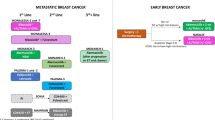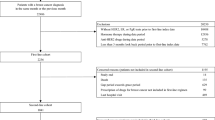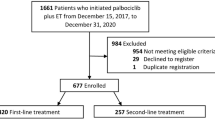Abstract
Objectives
This study aims in optimizing and predicting the in-vivo activity of AT9283 as a monotherapy and evaluating its combination with paclitaxel.
Design and Methods
The effectiveness of AT9283 was examined in several mouse models engrafted with BCR-ABL+ leukemic, human multiple myeloma (MM), and human colorectal carcinoma (HCT116) cells. Dose modeling was performed by analyzing previously published data of AT9283 cancer growth inhibition in vivo. The effects of 2 cycles (7.5–12.5 mg/kg AT9283 twice daily, 5 days/week), 4 cycles (45 mg/kg AT9283 once daily, twice/week), and 3 cycles (10 mg/kg AT9283 twice daily for 5 days or 12.5 mg/kg paclitaxel once/week followed by 5 mg/kg AT9283 twice daily for 4 days) on xenograft growth were quantified to identify the energy yield associated with the different doses.
Results
The continuous infusion regimens (5 days/week) used in the mice engrafted with BCR-ABL+ cells were more efficient than the regimens with twice weekly drug administration used in the mice engrafted with MM cells. The energy yield of the treatment regimen used in the BCR-ABL+ model was perfectly correlated (r = 1) with the AT9283 dose logarithm. An efficient dose-energy model with a perfect fit (R 2 = 1) estimating the energy yield achieved by the different AT9283 doses in optimal regimens was established with the aim of being able to administer patient-specific AT9283 doses. In the HCT116 model, the predicted response to AT9283 monotherapy was nearly identical to the actual response. The regimen combining paclitaxel (1050 mg/L) with low-dose AT9283 (3360 mg/L) used in the HCT116 model was equivalent to an optimal regimen of a higher dose of AT9283 (11,332 mg/L) alone.
Conclusions
Administering AT9283 via continuous infusion optimizes treatment, while combining it with paclitaxel significantly reduces the required AT9283 dose for the advanced-stage tumors with low mitotic index.

ᅟ


Similar content being viewed by others
References
Carmena M, Earnshaw WC. The cellular geography of Aurora kinases. Nat Rev Mol Cell Biol. 2003;4:842–54.
Bolanos-Garcia VM. Aurora kinases. Int J Biochem Cell Biol. 2005;37:1572–7.
Giet R, Prigent C. Aurora/Ipl1p-related kinases, a new oncogenic family of mitotic serine-threonine kinases. J Cell Sci. 1999;112:3591–601.
Taylor S, Peters JM. Polo and Aurora kinases—lessons derived from chemical biology. Curr Opin Cell Biol. 2008;20:77–84.
Dawson MA, Curry JE, Barber K, Beer PA, Graham B, Lyons JF, et al. AT9283, a potent inhibitor of the Aurora kinases and JAK2, has therapeutic potential in myeloproliferative disorders. Br J Haematol. 2010;150:46–57.
Howard S, Berdini V, Boulstridge JA, Carr MG, Cross DM, Curry J, et al. Fragment-based discovery of the pyrazol-4-yl urea (AT9283), a multitargeted kinase inhibitor with potent Aurora kinase activity. J Med Chem. 2009;52:379–88.
Curry J, Angove H, Fazal L, Lyons J, Reule M, Thompson N, et al. Aurora B kinase inhibition in mitosis: strategies for optimising the use of Aurora kinase inhibitors such as AT9283. Cell Cycle. 2009;8:1921–9.
Scharer CD, Laycock N, Osunkoya AO, Logani S, McDonald JF, Benigno BB, et al. Aurora kinase inhibitors synergize with paclitaxel to induce apoptosis in ovarian cancer cells. J Transl Med. 2008;6:79.
Kimura S. AT-9283, a small-molecule multi-targeted kinase inhibitor for the potential treatment of cancer. Curr Opin Investig Drugs. 2010;11:1442–9.
Arkenau HT, Plummer R, Molife LR, Olmos D, Yap TA, Squires M, et al. A phase I dose escalation study of AT9283, a small molecule inhibitor of Aurora kinases, in patients with advanced solid malignancies. Ann Oncol. 2012;23:1307–13.
Schiff PB, Fant J, Horwitz SB. Promotion of microtubule assembly in vitro by taxol. Nature. 1979;22:665–7.
Kuman N. Taxol induced polymerization of purified tubulin. Mechanism of action. J Biol Chem. 1981;256:10435–41.
Rowinsky EK, Donehower RC, Jones RJ, Tucker RW. Microtubule changes and cytotoxicity in leukemia cell lines treated with taxol. Cancer Res. 1988;48:4093–100.
Soncini C, Carpinelli P, Gianellini L, Fancelli D, Vianello P, Rusconi L, et al. PHA-680632, a novel Aurora kinase inhibitor with potent antitumoral activity. Clin Cancer Res. 2006;12:4080–9.
Gizatullin F, Yao Y, Kung V, et al. The Aurora kinase inhibitor VX-680 induces endoreduplication and apoptosis preferentially in cells with compromised p53-dependent postmitotic checkpoint function. Cancer Res. 2006;66:7668–77.
Moawad EY. Clinical and pathological staging of the cancer at the nanoscale. Cancer Nanotechnol. 2012;3:37–46.
Moawad EY. Reconciliation between the clinical and pathological staging of cancer. Comp Clin Pathol. 2014;23:255–62.
Moawad EY. Safe cancer screening for patients after lumpectomy, survivors, and healthy subjects. Cancer Oncol Res. 2013;1:15–23.
Moawad EY. Pathologic cancer staging by measuring cell growth energy. Cancer Oncol Res. 2013;1:69–74.
Moawad EY. Induction of multiple sclerosis and response to tyrosine kinase inhibitors. Indian J Clin Biochem. 2014;29:491–5.
Moawad EY. Induction of rheumatoid arthritis and response to tyrosine kinase inhibitors. Univ J Med Sci. 2013;1:50–5.
Moawad EY. The mechanism by which chronic myeloid leukemia responds to interferon-α treatment. Adv Pharmacol Pharm. 2013;1:88–94.
Moawad EY. Administering the optimum dose of l-arginine in regional tumor therapy. Indian J Clin Biochem. 2014;29:442–51.
Moawad EY. Identifying the optimal dose of ritonavir in the treatment of malignancies. Metab Brain Dis. 2014;29:533–40.
Moawad EY. Optimal standard regimen and predicting response to docetaxel therapy. Mutat Res Fundam Mol Mech Mutagen. 2014;770:120–7.
Moawad EY. Identifying and predicting the effectiveness of carboplatin in vivo and in vitro and evaluating its combination with paclitaxel. Indian J Gynecol Oncol. 2015;13:1–9.
Moawad EY. Predicting effectiveness of imatinib mesylate in tumors expressing platelet-derived growth factors (PDGF-AA, PDGF-BB), Stem cell factor ligands and their respective receptors (PDGFR-α, PDGFR-β, and c-kit). J Gastrointest Canc. 2015;46(3):272–83. doi:10.1007/s12029-015-9721-4.
Moawad E. Isolated system towards a successful radiotherapy treatment. Nucl Med Mol Imaging. 2010;44:123–36.
Moawad EY. Radiotherapy and risks of tumor regrowth or inducing second cancer. Cancer Nanotechnol. 2011;2:81–93.
Moawad EY. Safe doses and cancer treatment evaluation. Cancer Oncol Res. 2013;1:6–11.
Moawad EY. Nuclear transmutation and cancer in the biological cell. Int J Biochem Biophys. 2013;1:1–8.
Moawad EY. Cell growth energy represents a measure for man health; regulates nuclear transmutations and aberrant activation in human cell. Univ J Med Sci. 2013;1:27–35.
Moawad EY. Optimizing bioethanol production through regulating yeast growth. Energy Syst Synth Biol. 2012;6:61–8.
Moawad EY. Growth energy of bacteria and the associated electricity generation in fuel cells. Bioeng Biosci. 2013;1:5–10.
Moawad EY. Mass-energy conversion in the decaying system and doubling time-energy conversion in the biological system. J Phys Res Rev. 2015;1:1–13.
Tanaka R, Squires MS, Kimura S, Yokota A, Nagao R, Yamauchi T, et al. Activity of the multitargeted kinase inhibitor, AT9283, in imatinib-resistant BCR-ABL-positive leukemic cells. Blood. 2010;116:2089–95.
Santo L, Hideshima T, Cirstea D, Bandi M, Nelson EA, Gorgun G, et al. Antimyeloma activity of a multitargeted kinase inhibitor, AT9283, via potent Aurora kinase and STAT3 inhibition either alone or in combination with lenalidomide. Clin Cancer Res. 2011;17:3259–71.
Kyprianou N, English HF, Davidson NE, Isaacs JT. Programmed cell death during regression of the MCF-7 human breast cancer following estrogen ablation. Cancer Res. 1991;1:162–6.
Steel GG. Growth kinetics of tumours. Cell population kinetics in relation to the growth and treatment of cancer. Oxford: Clarendon Press; 1977.
Talmadge JE, Singh RK, Fidler IJ, Raz A. Murine models to evaluate novel and conventional therapeutic strategies for cancer. Am J Pathol. 2007;170:793–804.
Durland-Busbice S, Reisman D. Lack of p53 expression in human myeloid leukemias is not due to mutations in transcriptional regulatory regions of the gene. Leukemia. 2002;16(10):2165.
Keen N, Taylor S. Aurora-kinase inhibitors as anticancer agents. Nat Rev Cancer. 2004;4:927–36.
Nair JS, Ho AL, Tse AN, Coward J, Cheema H, Ambrosini G, et al. Aurora B kinase regulates the postmitotic endoreduplication checkpoint via phosphorylation of the retinoblastoma protein at serine 780. Mol Biol Cell. 2009;20:2218–28.
Margolis RL, Lohez OD, Andreassen PR. G1 tetraploidy checkpoint and the suppression of tumorigenesis. J Cell Biochem. 2003;88:673–83.
Podesta JE, Sugar R, Squires M, Linardopoulos S, Pearson ADJ, Moore AS. “Adaptation of the plasma inhibitory activity assay to detect Aurora, ABL and FLT3 kinase inhibition by AT9283 in pediatric leukemia.”. Leuk Res. 2011;35(9):1273–5.
Conflict of Interest
The author declares no conflict of interest.
Author information
Authors and Affiliations
Corresponding author
Additional information
Clinical Practice Points
• AT9283 has been investigated as a monotherapy in patients with advanced solid tumors at centers in the UK, USA, and Canada.
• Although the ability of AT9283 to inhibit growth of cancer and metastasis has been confirmed, previous studies have reported puzzling results about the efficiency of AT9283 therapy due to its cell cycle-specific effect.
• Other studies have suggested paclitaxel to synergize apoptosis in AT9283 therapy.
• Also the antitumor target of AT9283 has not yet been identified to optimize therapy by predicting the response of patients before therapy to provide a protection against treatment failure.
• In the present study, we identify for the first time a predictable antitumor target of AT9283 and evaluate its combination with paclitaxel.
Highlights
<In vivo effects of AT9283 (AT) doses were monitored to identify energy of those doses>
<The energy yield by AT dose was perfectly correlated (r = 1) with the AT dose logarithm>
<Dose-energy model with perfect fit (R2 = 1) was established to estimate the personalized dose>
<Scheduling AT alone in continuous infusion along the doubling time optimizes therapy>
<Combining paclitaxel with AT significantly reduces the required high dose of AT alone>
Rights and permissions
About this article
Cite this article
Moawad, E.Y. Optimizing and predicting the in vivo activity of AT9283 as a monotherapy and in combination with paclitaxel. J Gastrointest Canc 46, 380–389 (2015). https://doi.org/10.1007/s12029-015-9761-9
Published:
Issue Date:
DOI: https://doi.org/10.1007/s12029-015-9761-9




